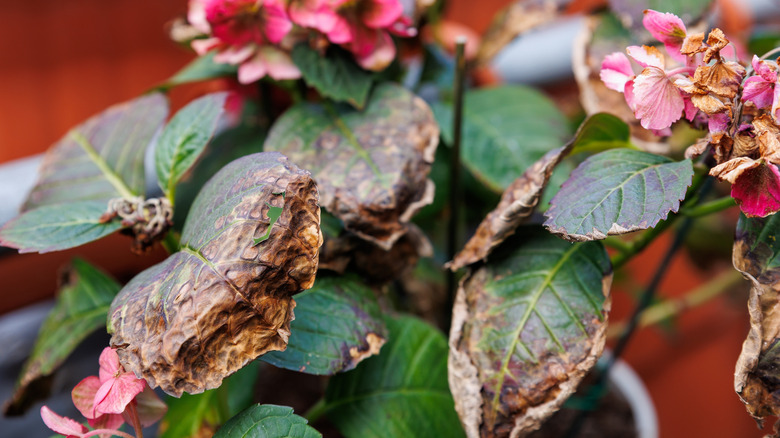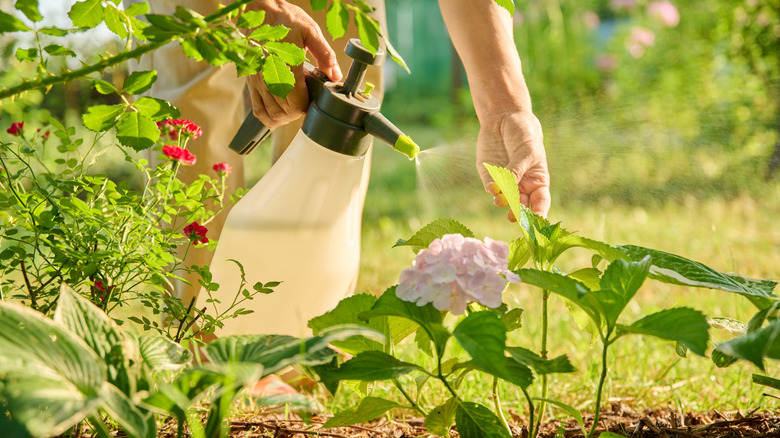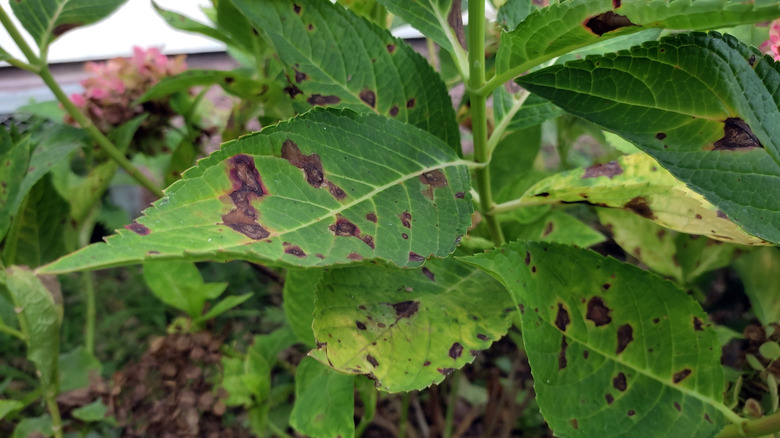Why Your Hydrangea Leaves Are Browning, And The Best Way To Fix It
The morning sun hits your hydrangea, and for a moment, its green leaves seem to glow. But then you spot brown edges creeping in, drying and curling where they shouldn't. It's easy to feel worried, but browning leaves are surprisingly common and usually just your plant's way of signaling it needs a bit of help. The most common culprits for this kind of hydrangea problem include inconsistent watering, imbalanced soil pH, fungal disease, and heat stress.
Among these, watering issues tend to top the list. Hydrangea flowers need steady moisture to stay healthy, but if the soil dries out too much, the leaf edges turn crispy and brown. On the other hand, too much water can drown the roots and make it harder for the plant to send moisture up to the leaves. The sun can do its share of damage, too. When temperatures soar or winds pick up, plants may lose moisture faster than their roots can replenish it. Without enough water to reach every part of the leaf, some tissues dry out and die, often leaving behind brown, brittle edges.
Sometimes the browning leaves problem comes from the soil itself. Hydrangeas like slightly acidic conditions, and when the pH gets too high, they have trouble pulling in nutrients like iron. That can leave the leaves yellow with green veins at first, then appear as brown spots as the problem worsens. Occasionally, insects like aphids or four-lined plant bugs, pierce the leaves to feed on sap, sometimes leaving behind scattered brown specks. Once you figure out what's causing those brown leaves, most of the fixes are pretty easy.
Adjust your watering and sunlight to protect hydrangea leaves
To figure out what the problem is, start by taking a closer look at your watering routine. Hydrangea flowers love steady moisture, but they don't want to sit in soggy soil. The goal is slow, deep watering right at the base of the plant so the roots get a good drink. A gentle trickle from the hose works great for this. Watering in the morning helps ensure the plant is fully hydrated before the heat of the day kicks in.
If too much sun has been the issue, adjusting your plant's location or providing some shade can make a huge difference. Hydrangeas generally do best with morning sunlight and afternoon shade. If your plant is sitting in harsh sun all day, consider relocating it or using shade cloth during heat waves to protect those delicate leaves. Giving the plant some shelter from intense sun and hot winds will help prevent scorch marks and keep the leaves looking fresh. In particularly hot regions, some hydrangea varieties handle heat better than others, so choosing a more heat-tolerant cultivar might help in the long term.
Use mulch, pest control, and pH fixes to keep your hydrangea healthy
There are a few more ways you can help your hydrangea bounce back. Adding mulch around the base of the plant is one of the easiest steps. A 3-inch layer of organic mulch helps the soil stay evenly moist and protects the roots from extreme temperatures. Just be sure to keep the mulch pulled slightly away from the base of the stems to prevent rot from too much moisture right against the plant.
If your soil's pH is part of the problem, there are simple ways to adjust it without harsh chemicals. Some varieties of hydrangeas prefer slightly acidic to neutral soil. So if your soil is too alkaline, mixing in organic compost or peat moss over time can naturally lower the pH. If you need to adjust the pH more quickly, a little sulfur can safely nudge it down— just follow the directions and give it time to work. Avoid dumping quick fixes like aluminum sulfate, which can do more harm than good.
Finally, it's also worth giving your hydrangea a closer look for any tiny pests. While bugs aren't usually the main cause of brown leaves, sap-sucking insects like aphids, scale, or spider mites can leave behind little brown or black dots where they feed. If you spot them, you don't need to panic. For small outbreaks, a strong blast of water or a little hand-picking is often all it takes to clear pests from hydrangeas. But if the infestation's getting serious, call a pest control expert to get it under control before it spreads.


